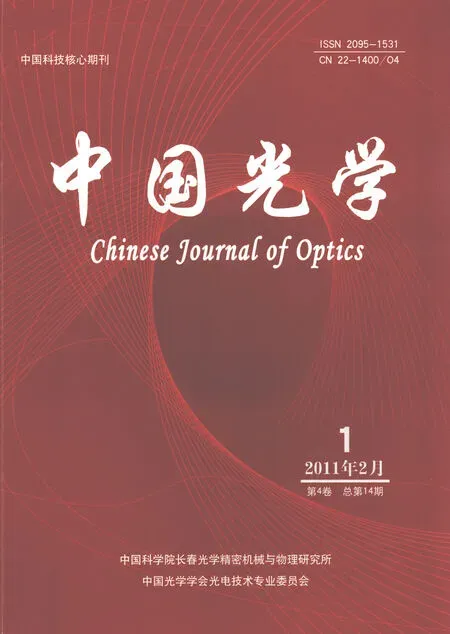封闭空间中易燃混合气体在HF和CO2激光作用下的燃烧引发
FIRSOV K N,KAZANTSEV S Yu,KONONOV I G,KOSSYI I A,TARASOVA N M,张来明,谢冀江
封闭空间中易燃混合气体在HF和CO2激光作用下的燃烧引发
FIRSOV K N1,KAZANTSEV S Yu1,KONONOV I G1,KOSSYI I A1,TARASOVA N M1,张来明2,谢冀江2
(1.俄罗斯科学院普罗霍罗夫普通物理研究所,莫斯科119991;2.中国科学院长春光学精密机械与物理研究所,激光与物质相互作用国家重点实验室,吉林长春130033)
1 Introduction
In recent years,laser ignition has been addressed in many papers[1,2]in connection with its possible practical applications.However,the mechanisms for initiating ignition are not yet completely understood. That is why investigation of the mechanisms for laser ignition of gas mixtures remains a challenging problem.It should be noted that the interest in laser ignition is also stimulated by the fact that laser provides a“pure”modeling of different ignition methods.The present paper is an experimental investigation of the dynamics of gas mixtures ignited by a Laser Spark(LS)or by heating a gas layer with a pulse laser heating.
2 Experimental Technique
A schematic of the experiment is shown in Fig.1. The cylindrical quartz chamber with an inner diameter of 44 mm was evacuated to a pressure less than 13.3 Pa and was filled with a gas mixture:CH4∶O2=1∶2 at pressures of 18≤p≤40 kPa and mixtures CH4∶O2∶SF6=3∶6∶1(3∶6∶2)at a total pressure of 20(22)kPa.One end of the chamber was equipped with a solid metal flange,and the other end,with a flange having a BaF2window for injecting laser pulses.Different circular diaphragms and calibrated filters were placed in front of the window in order to attenuate laser.

Fig.1 Schematic of the experiment:reactor chamber:a quartz tube with length of 25-30 cm,lightguides:(AvaSpec)-spectrograph,P:photodiode,PER-7:streak camera,LS:laser spark,D:circular diaphragm,A:calibrated attenuators of laser light,and L:BaF2(NaCl)lens.
Experiments were carried out with a pulsed electric-discharge CO2laser[3]and a non-chain electrochemical Hydrogen Fluorine(HF)laser[1,4].The HF laser operated at a wavelength of 2.65-3 μm, the pulse duration and energy in 140 ns and 4 J,respectively;the CO2laser operated at the P20 line(λ=10.6 μm),the pulse energy was 60 J,the pulse duration was 3 μs,and the pulse profile was a typical of Transversely Excited Atmospheric pressure(TEA)CO2lasers[5].
An LS for igniting gas mixtures was excited at the axis of the cylindrical chamber at a distance of~3 cm from the window by focusing laser by a BaF2lens with the focal length F=10 cm.In the LH method,a small(2-4 kPa)amount of SF6was added to gas mixtures,which were then heated and ignited by a CO2laser.Sulphur hexafluoride SF6strongly absorbs radiation from such a laser in the P20 line,thereby providing heating of the mixture.An analysis[5]shows that,under our experimental conditions,the energy stored in the vibrational degrees of freedom of an SF6molecule is converted into heat in less than 1 μs.Hence,by the end of the pulse(3 μs at a level of 0.1 of the maximum pulse amplitude),the laser energy absorbed by the gas is completely converted into heat(and thermal equilibrium is established).In order to determine how the equilibrium temperature established by the end of the pulse was distributed along the tube,the dependence of light transmission of the gas mixtures under investigation on the energy density of the incident CO2laser light was determined by a method similar to that used in the Ref.[5].
The dynamics of the mixture ignition and burning were analyzed by using an FD-25k photodiode and a PER-7 high-speed photodetector,which made it possible to photograph discharges in the reactor in a continuous sweep mode.The slit of the photodetector was oriented along the optical axis of the cylindrical chamber(the Z axis).A spectral analysis of the emission from the gas and of the time evolution of the emission from different cross sections along the quartz tube was carried out,respectively,with an AvaSpec-2048 spectrograph(produced by the Avantes company from the Netherlands)and an PEM-106 photomultiplier.The light emitted from the gas in the quartz tube was guided to spectrograph and photomultiplier through lightguides.
3 Results
Fig.2(a)shows a representative photograph of a discharge in the reactor chamber,taken with a PER-7 photoelectric detector,and Fig.2(b)shows an oscillogram of a signal from the photodiode.A CH4∶O2∶SF6=45∶90∶15 gas mixture was ignited by heating by a CO2laser.In the photograph,the horizontal axis is the time axis and the vertical axis is the spatial axis.The characteristic time and spatial scales are indicated in the figures.
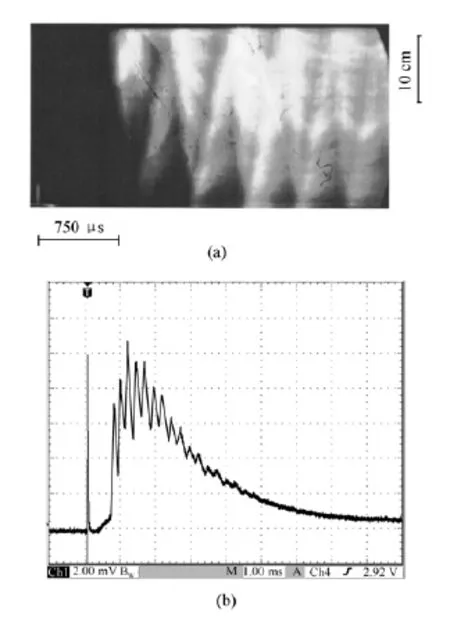
Fig.2 (a)Photograph of the ignition of a gas mixture CH4∶O2∶SF6=45∶90∶15,taken with a photoelectric detector;(b)oscillogram of a signal from the photodiode(scale of 2 mV/div,time scale of 1 ms/div).D=18 mm,Win=2.6 J/cm3.
The dynamic pattern of ignition of gas mixtures by a freely localized laser spark[1]is similar to that shown in Fig.2.The ignition by heating by a CO2laser has the following distinctive features:
(i)the induction time is substantially shorter;(ii)the gas temperature established immediately after the burning of the mixture is substantially higher(the temperature was determined from spectroscopic observations in the same manner as was done in [1]);and(iii)at energy densities slightly above that of the incident CO2laser light,it was observed that the burning rate increased sharply and the chamber exploded.
Fig.3(a)shows a representative photograph of the explosion in the reactor chamber taken with a PER-7 photoelectric detector,and Fig.2(b)shows an oscillogram of a signal from the photodiode.
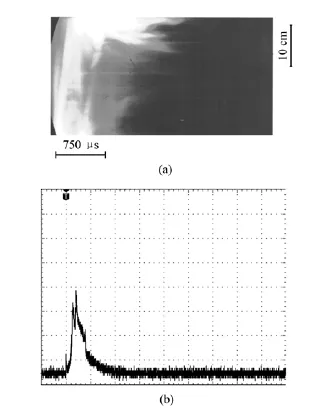
Fig.3 (a)Photograph of the explosion of a gas mixture CH4∶O2∶SF6=45∶90∶15,taken with a photoelectric detector;(b)oscillogram of a signal from the photodiode(scale of 10 mV/div,time scale of 1 ms/division).D=18 mm,Win=4.5 J/ cm3.
Fig.4 shows the typical spectrum of radiation from a burning mixture of CH4∶O2∶SF6=45∶90∶15,obtained at different initiation energies.Appropriate spectra,normal ignition and explosion-not qualitatively are different.
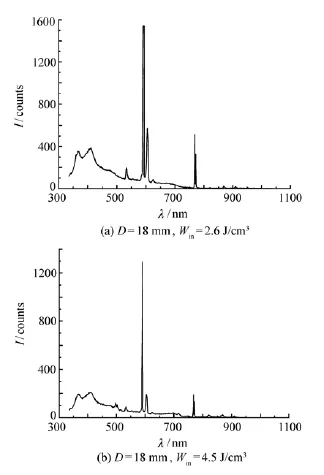
Fig.4 The characteristic spectrum of radiation from a burning mixture CH4∶O2∶SF6=45∶90∶15. The time delay power on the pulse of CO2laser,initiating ignition,relative to the triggering of the spectrograph is about 0.5 ms,and the time of exposition is about 1 ms.
Presumably,the main reasons for these burning features of gas mixtures in the case of ignition by LH under our experimental conditions are the excitation of shock wave perturbations at the boundaries of the irradiated region and the nonlocal nature of ignition(the gas was ignited in a fairly large volume).Another possible reason why the ignition by LH is intensified may be the decomposition of SF6molecules by multiphoton dissociation.Fig.5 shows gas temperature distributions established along the axis of the cylindrical chamber immediately after a CO2laser pulse.The distributions were calculated for two energy densities of incident CO2laser at which the ignition was stable,Win=1.6 J/cm2;the gas mixture was detonated,Win=2.5 J/cm2;and the diam-eter of the circular diaphragm in front of the input window is 29 mm.It is seen that the gas was heated in a large volume within the chamber,and the notable features are a low ignition temperature and a short induction time(tind≈650 μs).
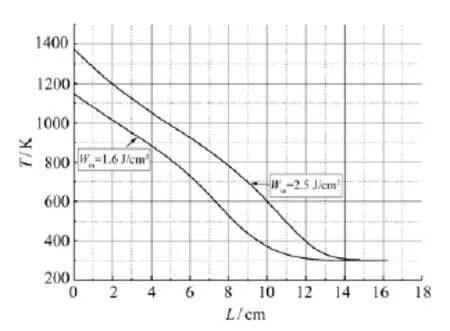
Fig.5 Gas temperature distributions in a gas mixture along the cylindrical chamber immediately after a laser pulse,calculated for two energy densities of incident CO2laser light,Win=1.6 and 2.5 J/cm2.
4 Conclusions
In experiments with laser beams passing through the circular diaphragms that were placed in front of the input window of the chamber,it was found that,for each diameter of the diaphragms,there were two threshold laser energy densities, W1thrand W2thr,above the first of which(W1thr<Win<W2thr)the gas mixture was ignited,and above the second(Win<W2thr),it was rapidly burned out and the chamber exploded(detonation regime).In the second case,however, the combustion wave velocity still remained lower than the detonation wave velocity characteristic of a given gas mixture.It should be noted that,as in the Ref.[6],the ignition threshold for gas mixtures depended on the incident laser energy density;i.e.,as the diaphragm diameter was increased,the first threshold energy density W1thrdecreased approximately in inverse proportion to the diaphragm area.
[1]KAZANTSEV S Yu,KONONOV I G,KOSSYI I A,et al..Ignition of a combustible gas mixture by a laser spark excited in the reactor volume plasma[J].Plasma Phys.Rep.,2009,35:251-257.
[2]BEDUNEAU J-L,KIM B,ZIMMER L,et al..Measurements of minimum ignition energy in premixed laminar methane/air flow by using laser induced spark[J].Combust.Flame,2003,132:653-655.
[3]BELEVTSEV A A,FIRSOV K N,KAZANTSEV S Yu,et al..Self-sustained volume discharge in SF6-based gas mixtures upon the development of shock-wave perturbations of the medium initiated by a pulsed CO2laser[J].Quantum Electron.,2006,36:646-652.
[4]ANDREEV S N,FIRSOV K N,KAZANTSEV S Yu,et al..Temporal structure of an electric signal produced upon interaction of radiation from a HF laser with the bottom surface of a water column[J].Quantum Electron.,2009,39:179-184.
[5]BELEVTSEV A A,FIRSOV K N,KAZANTSEV S Yu,et al..The influence of vibrational excitation on the burning voltage of a pulsed electric discharge in HF laser working media[J].Appl.Phys.B,2006,82:455-462.
[6]BRATOV V A,ISAKOV L M,PETROV Yu V.A criterion for detonation initiation in gas mixtures[J].Physics-Doklady,2008,53:507-509.
Author′s biography:Sergey Kazantsev(1971—),Moscow,Russia,graduated from Moscow Engineering Physics Institute(State University)in 1998,His research interests are concerned with experimental investigation of volume selfsustained gas discharge phenomena,development of chemical and high-power electric discharge lasers,and investigation of high power laser beam interaction with matter,laser induced gas breakdown,laser lightning protection.E-mail:kazan@kapella.gpi.ru
Combustion initiation of flammable gas mixture in a closed volume by high power HF and CO2laser
FIRSOV K N1,KAZANTSEV S Yu1,KONONOV I G1,KOSSYI I A1,TARASOVA N M1,ZHANG Lai-ming2,XIE Ji-jiang2
(1.Prokhorov General Physics Institute,Russion Academy of Sciences,Moscow 119991,Russia;2.Stake Key Laboratory of Laser Interaction with Matter,Changchun Institute of Optics,Fine Mechanics and Physics,Chinese Academy of Sciences,Changchun 130033,China)
The ignition of stoichiometric CH4∶O2mixture in a closed cylindrical quartz chamber was investigated.Two methods of combustion initiation were used:mixture ignition by freely localized pulse HF laser produced laser spark and mixture ignition by direct gas heating with the help of a pulse CO2laser.In the latter case,the small admixture of SF6strongly absorbing CO2laser radiation was used for pulse heating of flammable mixture.Dynamics of combustion was investigated and the spectral characteristics of combustion glow were determined.The experiment demonstrates that rapid laser heating of a certain amount of reactive gas can significantly accelerate the process of inflammation and can realize the detonation mode of combustion gas mixture,even in a small reactor volume.Initial gas temperature distributions along chamber axis for threshold conditions are obtained.
cylindrical quartz chamber;combustion initiation mode;pulse HF laser;CO2laser radiation;spectral characteristics;temperature distribution
研究了封闭圆柱石英腔中化学计量CH4∶O2混合气的燃烧试验。使用了非定域脉冲HF激光触发和直接使用脉冲CO2激光器助燃两种引燃方法。第二种引燃方法是使用小剂量的可以强烈吸收脉冲CO2激光辐射的SF6来加热易燃混合气。研究了燃烧过程,并确定了燃烧辉光的谱线特征。试验表明,即使在小体积反应器中,固定数量反应气的快速激光加热也能够极大地加速燃烧进程并达到混合气燃烧的爆炸模式。得到了阈值情况下沿腔轴的初始温度分布。
圆柱石英腔;燃烧引发方式;脉冲HF激光;CO2激光辐射;光谱特性;温度分布
TN249
A
1674-2915(2011)01-0041-05
2010-09-21;
2010-12-03
book=42,ebook=44

